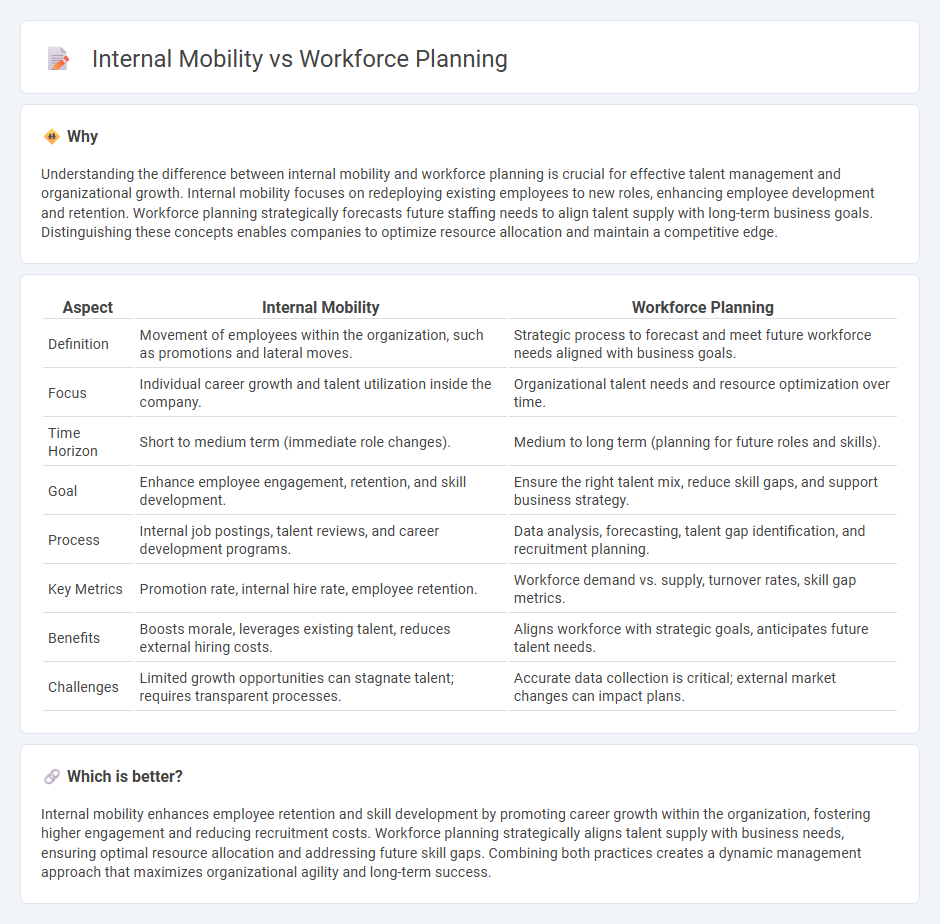
Internal mobility enhances employee engagement and retention by facilitating career growth within the organization, while workforce planning strategically aligns talent supply with business needs to optimize productivity. Balancing these approaches ensures a dynamic, adaptable workforce that meets evolving market demands. Explore how integrating internal mobility with workforce planning drives sustainable organizational success.
Why it is important
Understanding the difference between internal mobility and workforce planning is crucial for effective talent management and organizational growth. Internal mobility focuses on redeploying existing employees to new roles, enhancing employee development and retention. Workforce planning strategically forecasts future staffing needs to align talent supply with long-term business goals. Distinguishing these concepts enables companies to optimize resource allocation and maintain a competitive edge.
Comparison Table
| Aspect | Internal Mobility | Workforce Planning |
|---|---|---|
| Definition | Movement of employees within the organization, such as promotions and lateral moves. | Strategic process to forecast and meet future workforce needs aligned with business goals. |
| Focus | Individual career growth and talent utilization inside the company. | Organizational talent needs and resource optimization over time. |
| Time Horizon | Short to medium term (immediate role changes). | Medium to long term (planning for future roles and skills). |
| Goal | Enhance employee engagement, retention, and skill development. | Ensure the right talent mix, reduce skill gaps, and support business strategy. |
| Process | Internal job postings, talent reviews, and career development programs. | Data analysis, forecasting, talent gap identification, and recruitment planning. |
| Key Metrics | Promotion rate, internal hire rate, employee retention. | Workforce demand vs. supply, turnover rates, skill gap metrics. |
| Benefits | Boosts morale, leverages existing talent, reduces external hiring costs. | Aligns workforce with strategic goals, anticipates future talent needs. |
| Challenges | Limited growth opportunities can stagnate talent; requires transparent processes. | Accurate data collection is critical; external market changes can impact plans. |
Which is better?
Internal mobility enhances employee retention and skill development by promoting career growth within the organization, fostering higher engagement and reducing recruitment costs. Workforce planning strategically aligns talent supply with business needs, ensuring optimal resource allocation and addressing future skill gaps. Combining both practices creates a dynamic management approach that maximizes organizational agility and long-term success.
Connection
Internal mobility enhances workforce planning by aligning employee skills and career aspirations with organizational talent needs, enabling strategic deployment of human resources. Effective workforce planning identifies skill gaps and future roles, promoting targeted internal mobility to fill positions efficiently and reduce recruitment costs. This synergy increases employee retention, engagement, and organizational agility in responding to market changes.
Key Terms
Workforce Planning:
Workforce planning involves analyzing current workforce capabilities, forecasting future talent needs, and developing strategies to address skill gaps to ensure organizational goals are met. It includes data-driven assessments of employee competencies, demographic trends, and labor market conditions to optimize staffing levels and enhance productivity. Explore how effective workforce planning can transform talent management and drive business success.
Talent Forecasting
Talent forecasting plays a critical role in workforce planning by predicting future skill requirements and aligning hiring strategies accordingly. Internal mobility enhances this process by facilitating the redeployment of existing employees, thus optimizing talent utilization and reducing recruitment costs. Explore how integrating talent forecasting with internal mobility strategies can drive agile and efficient workforce management.
Succession Planning
Workforce planning strategically assesses future talent needs to ensure the right skills are available, while internal mobility leverages existing employees to fill critical roles, enhancing succession planning by preparing internal candidates for leadership transitions. Effective succession planning integrates workforce planning data with internal mobility strategies to identify and develop high-potential employees, reducing hiring costs and minimizing business disruption. Explore how aligning these practices can strengthen organizational resilience and future-proof leadership pipelines.
Source and External Links
What Is Workforce Planning? Strategies and Benefits - This article dives into workforce planning, covering its process, strategies, and benefits to align staffing needs with an organization's long-term goals.
Workforce Planning: Definition, Process and Principles - This resource provides a comprehensive overview of workforce planning, including its definition and the steps involved in analyzing supply and demand for talent.
A Guide to Workforce Planning: Process, Strategies, & - This guide covers strategic workforce planning, emphasizing its importance in ensuring the right talent is in place to support business objectives and growth.
 dowidth.com
dowidth.com